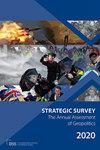Strategic Policy
Q4 Social Sciences
引用次数: 0
Abstract
Major wars severely test armed forces. The Russia–Ukraine war is no exception. Although there are currently only two direct combatants, many other states are involved in the conflict: politically, diplomatically and economically, and by providing military and intelligence assistance to Kyiv. They have supplied Ukraine with considerable military support, including a wide variety of weapons, ammunition, spare parts and training. The international effort to prevent Russia from winning the war has also seen self-organised participation by international businesses in withdrawing from Russia and, in some cases, helping Ukraine. At the time of writing, the outcome and duration of the war cannot be reliably forecast. But it has demonstrated some key features of modern war between states. It has reaffirmed that war is a highly dynamic contest of wills across multiple domains, where both sides seek to outfight, outmanoeuvre and out-adapt each other. The battle of the narrative is a key factor. The war reminds us that the prime military capability is competence and that numbers and mass still count, both on the battlefield and in logistics stockpiles. It also suggests that many current precision weapons are limited by cost, complexity and lead times to manufacture; and that it Chapter 4战略政策
重大战争严重考验着武装力量。俄乌战争也不例外。尽管目前只有两名直接战斗人员,但许多其他国家也参与了冲突:政治、外交和经济,以及向基辅提供军事和情报援助。他们向乌克兰提供了大量军事支持,包括各种各样的武器、弹药、备件和训练。在阻止俄罗斯赢得战争的国际努力中,国际企业也自行组织参与了从俄罗斯撤军的行动,在某些情况下还帮助了乌克兰。在撰写本文时,战争的结果和持续时间无法可靠预测。但它展示了现代国家间战争的一些关键特征。它重申,战争是一场跨越多个领域的高度动态的意志竞赛,双方都寻求超越、超越和超越对方。叙事的战斗是一个关键因素。这场战争提醒我们,首要的军事能力是能力,无论是在战场上还是在后勤储备中,数量和质量仍然很重要。它还表明,目前许多精确武器受到成本、复杂性和制造周期的限制;第四章
本文章由计算机程序翻译,如有差异,请以英文原文为准。
求助全文
约1分钟内获得全文
求助全文

 求助内容:
求助内容: 应助结果提醒方式:
应助结果提醒方式:


